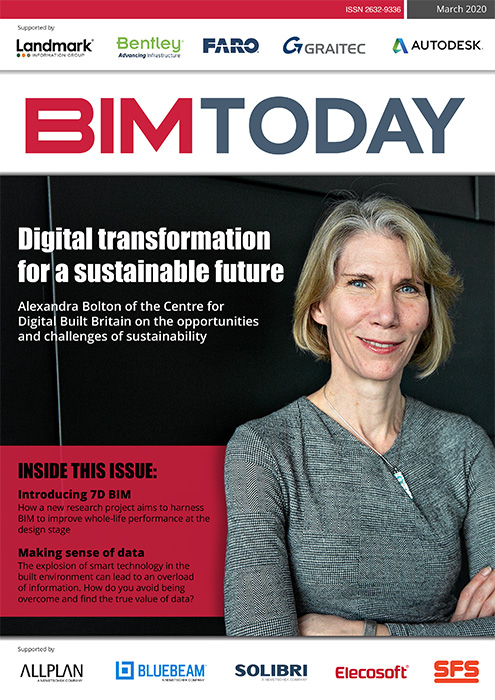Welcome to the March edition of BIM Today. In this issue, we look at the role of digital transformation in achieving a sustainable future, the evolution of the digital twin in infrastructure, how to cope with the ever-growing flow of data from smart buildings and a pioneering research project into 7D BIM
In this edition of BIM Today, Alexandra Bolton, executive director the Centre for Digital Built Britain, discusses the tools and processes being developed by the Centre and the Construction Innovation Hub to support the creation of a green information economy and a sustainable built environment.
Elsewhere, we find out about a pioneering research project into 7D BIM, which combines digital technology, big data and artificial intelligence to accurately predict lifetime costs and carbon emissions, allowing architects, engineers and builders to understand the long-term implications of different design options.
Meanwhile, George Adams of SPIE UK looks at how to avoid information overload in the age of smart tech and realise the true value of data generated from buildings.
We also hear from Keith Bentley of Bentley Systems on the evolution of the digital twin and preview this year’s Futurebuild, which takes place from 3-5 March at ExCeL, London, and its new focus on digital construction.
There’s a host of case studies too, showing how BIM is helping to deliver projects around the world, often in some challenging conditions and locations.
Here’s a selection of what’s in store in this edition of BIM Today:
Sustainability is a key driver to digital transformation in the environment. Alexandra Bolton, executive director of the Centre for Digital Built Britain (CDBB) and a member of the Construction Innovation Hub senior management team, considers the challenge, the opportunity and the potential prize.
A new research project between architect Cartwright Pickard and the Mackintosh School of Architecture at the Glasgow School of Art integrates whole-life cost estimation with BIM to assist building design and ultimately reduce costs, waste and carbon emissions.
Futurebuild 2020 comes to London’s ExCeL from 3-5 March, bringing together hundreds of exhibitors and thousands of visitors from across the built environment sector. BIM Today previews this year’s show, which will have a new focus on digital construction
As digital twins advance beyond BIM and GIS, what do you need to know? Bentley’s founder, Keith Bentley, offers sage advice to help you make an impact.
The drive for greater sustainability is fuelling an explosion in smart tech in buildings – but this brings the challenge of coping with an ever-growing data flow. George Adams, director of energy and engineering at SPIE UK, looks at how to overcome information overload and extract genuine value from smart buildings.
A new government-backed R&D project involving Costain, TerOpta and the University of the West of England aims to harness AI and building sensors to help businesses optimise their energy efficiency.
WSP took on multiple complex challenges to create two new basement levels in one of London’s most famous buildings – Admiralty Arch.
Mace Tech’s High Rise Solutions combines BIM and digital technology with an on-site, self-contained factory approach to reduce construction times while improving quality.
The Forestry Commission is using the latest high-resolution imagery to create 3D visualisations of woodland management projects.
Larsen & Toubro have advanced BIM for rail on the second phase of India’s Western Dedicated Freight Corridor.


